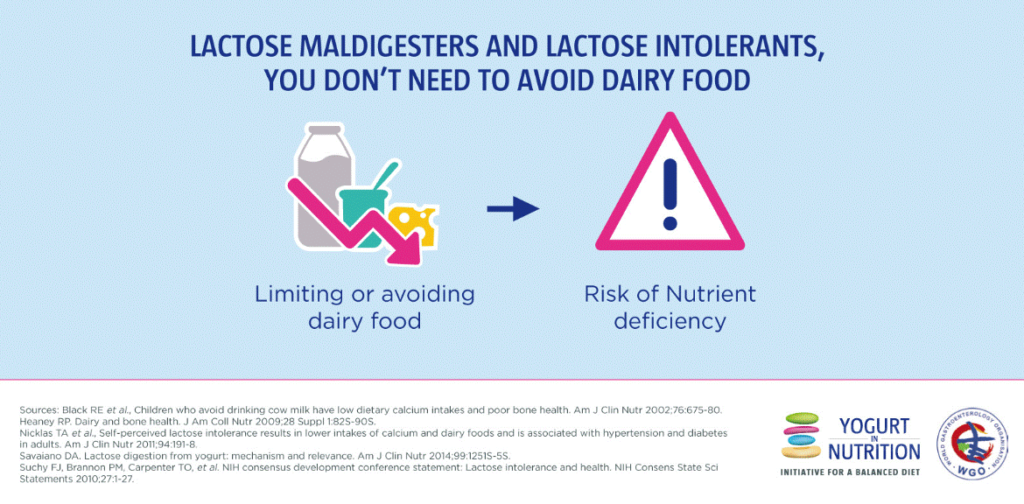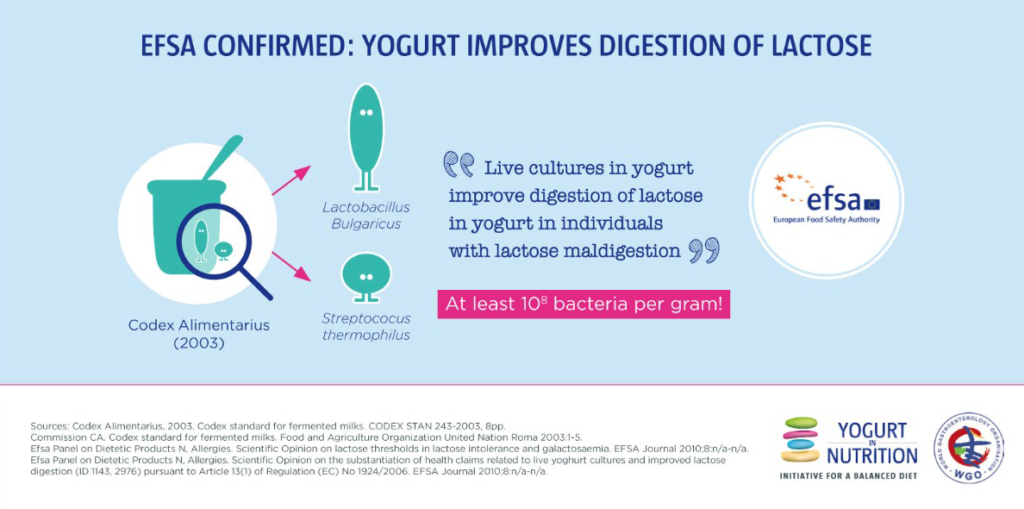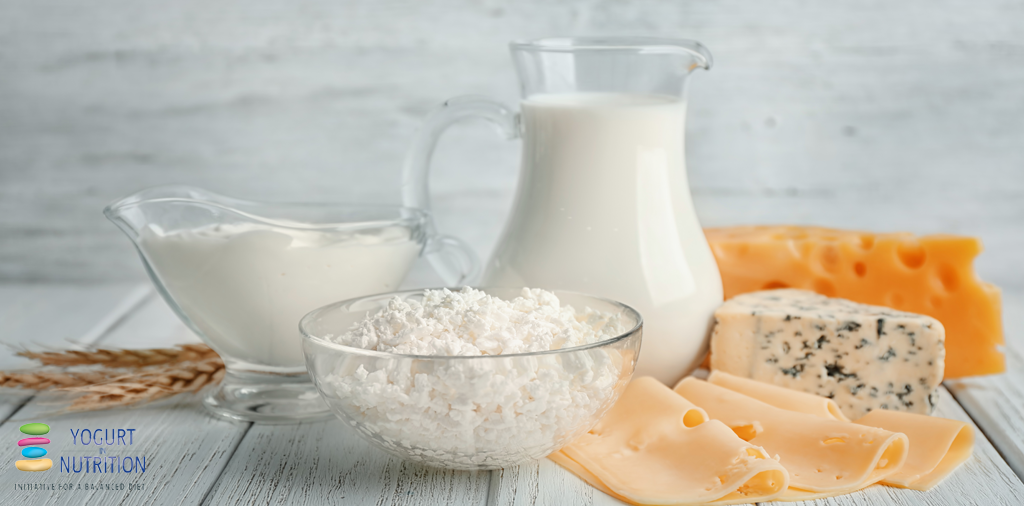By Azmina Govindji RD MBDA, Consultant Nutritionist & Registered Dietitian.
My life’s work has been about helping people to eat better using evidence-based knowledge and realistic, achievable goals that are tailored to an individual’s lifestyle. So, when I hear of people unnecessarily restricting their diet through having heard about a recent trend, or through online research via unqualified sources, I feel compelled to reassure them of the wonderful variety of foods that they can and should eat in order to improve their nutritional status.
Yogurt is one of those foods that I’ve noticed people avoid when they believe they have an intolerance to lactose. Yet it is not necessary and indeed could be counter-productive to avoid yogurt for lactose intolerance or maldigestion. And often these dietary practices are adopted in the absence of any diagnosis, which is even more inappropriate.
Lactose Intolerance and Lactose Maldigestion
Lactose intolerance affects at least 70% of people of East Asian descent, and is also common in people of West African, Arab, Jewish, Greek, and Italian origin. Having said this, it affects only about 2% of people globally.
Lactose maldigestion on the other hand is estimated to affect around 70-75% of the global population. In both cases (lactose maldigestion and intolerance), only a fraction of lactose is digested. The non-digested lactose enters the colon where bacterial fermentation of this lactose can produce unpleasant symptoms. Lactose maldigestion can lead to clinical symptoms of lactose intolerance such as diarrhoea, bloating, stomach cramps and excessive flatulence.
Where’s the problem?
Since lactose is the sugar found in milk and yogurts, important nutrients such as calcium and iodine are compromised if people avoid dairy products in an aim to reduce symptoms such as bloating. But these symptoms are not necessarily indicative of lactose intolerance, and self-diagnosing via online searches appears to be becoming more popular. A 2013 US survey by the Pew Research Center found that 35% of Americans self-diagnose using information they found online.
It is not possible to self-diagnose lactose intolerance. Attempting self-diagnosis is counter-productive and can negatively impact nutritional status.
Welcome back to yogurt
Although lactose intolerance is an inability to digest lactose found in dairy products, I find that most of my patients with lactose intolerance can consume small amounts of lactose without experiencing symptoms. It varies from person to person, but some can manage around a glass of milk daily whereas others only tolerate milk in tea. Hard cheeses like cheddar are usually acceptable and the biggest surprise to them is that they can have yogurt.
In fact, I positively encourage them to have yogurt by explaining that the lactose in yogurt is digested more efficiently than any other dairy sources. I will tell them about the live bacteria in yogurt that produce their own lactase, helping to break down some of the lactose in yogurt. As a result, I find their symptoms improve on a low lactose diet with the inclusion of yogurt, and that they typically enjoy being able to eat yogurt again.

Kefir is a fermented dairy product that is made from various types of milk (cow, goat and buffalo). There have been reports that the nutritional make-up of kefir could be responsible for many positive effects such as anti-bacterial and immunological properties, and that it can be consumed by people with an intolerance to lactose. More research is needed to substantiate these health effects.
Another popular fermented milk is Skyr, which originates from the Icelandic diet. As in classic yogurt, it is made from Streptococcus thermophilus and Lactobacillus bulgaricus. Skyr is low in lactose as 90% is transformed during fermentation or removed by straining
Practical advice for lactose intolerance and maldigestion

My 8-point plan
- Cutting out dairy foods is unnecessary and can lead to reduced intakes of calcium and iodine.
- Most people with lactose intolerance or lactose maldigestion can generally tolerate up to 12 g of lactose (equivalent to about one glass of milk), when eaten at the end of a meal. Other foods in the meal will help to slow down digestion and this may lessen symptoms.
- If you’re nervous about introducing dairy foods into your diet, experiment by adding small amounts of milk and yogurt to foods. For example, add some milk to mashed potato, or add yogurt to salad dressing. You may find it easier to tolerate full-fat rather than low fat varieties.
- Enjoy up to two pots of yogurt daily. This is based on the EFSA claim that live cultures in yogurt improve digestion of lactose in yogurt in individuals with lactose maldigestion.
- Check food labels for lactose, milk, whey, milk solids, buttermilk, cream and curds and limit foods that cause you discomfort – you may find you can tolerate more than you think.
- If you are on a plant-based diet, check labels and choose calcium-fortified dairy alternatives as well as calcium-set tofu as a regular protein source.
- Eat other foods that provide calcium, e.g. fish with edible soft bones, such as canned salmon or sardines, dried beans, dried fruit such as figs and apricots, broccoli, kale, spinach, oranges and almonds.
- Take a vitamin D supplement of 10mcg a day, especially in winter months when the body is less exposed to UVB rays in sunlight
Don’t guess – get diagnosed
Many of my patients find they suffer from a level of digestive discomfort after meals and wrongly assume this is due to lactose intolerance. They then treat this as if it were a milk allergy and avoid milk, cheese and yogurt and all foods that contain them. This is a real worry on two counts. One that they have not been diagnosed using the hydrogen breath test, and secondly, avoiding dairy foods without substituting this with foods that also supply calcium, protein and iodine could mean they miss out on key nutrients. Not getting enough of these nutrients may increase the risk for chronic health problems, including osteoporosis and decreased bone health.
Often peer or social media influences inform these habits and I aim to empower them to always look at the credentials of anyone giving out dietary advice. You wouldn’t ask a car mechanic about your dental issues, so seek the guidance of a properly qualified registered dietitian or registered nutritionist for your nutrition advice.
Conclusion
Lactose intolerance is an important talking point because avoiding milk and yogurt can compromise essential nutrient intake and because it is often a perceived condition rather than a diagnosed one. I despair when young teenage girls believe they need to avoid dairy products in order to flatten their tummy – yet this is a time when they are laying down crucial strength in their bones, and when calcium and vitamin D as well as other nutrients are particularly important. More effort and creativity is needed to steer people away from fads such as trying a dairy-free diet without diagnosis.
People with a true lactose intolerance can enjoy up to two pots of yogurt a day since the live bacteria improve the digestion of lactose. Welcome back to yogurt!
Biography
Azmina Govindji RD, Founder of Azmina Nutrition, is an award-winning dietitian, consultant nutritionist, international speaker and best-selling author. She is a media spokesperson for the British Dietetic Association and is regularly quoted in the national press.
Her television appearances include Sky, BBC and ITV news, This Morning, Victoria Derbyshire show, the One Show, Inside the Factory and Food Unwrapped. She has written over a dozen books and specialises in diabetes, weight management, and plant-based eating.
Azmina is co-founder of the award-winning RDUK professional twitter chats, she was Chief Dietitian to Diabetes UK for eight years, and she now runs her own consultancy working with the food industry and the media to ensure that nutritional messages are accurate and evidence-based. Azmina is a member of the editorial board for the Yogurt in Nutrition Digests. Being a dietitian, she is regulated by the UK Health and Care Professions Council and is bound by a strict code of conduct.
Behind this professional exterior is Azmina’s down-to-earth attitude. She’s a busy mum of two with a lively personality and is skilled at finding realistic ways to help people eat better and embrace a healthier lifestyle.




